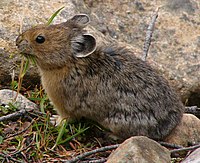
Photo from wikipedia
Abstract American pikas (Ochotona princeps), small mammals related to rabbits, occur in mountainous regions of western North America, where they live in shattered‐rock habitats (talus). Aspects of their physiology and… Click to show full abstract
Abstract American pikas (Ochotona princeps), small mammals related to rabbits, occur in mountainous regions of western North America, where they live in shattered‐rock habitats (talus). Aspects of their physiology and life history create situations that appear to put pikas at risk from warming climates. Some low‐elevation, warm sites that historically harbored pikas have become extirpated, and the assumption is that these will not be re‐colonized under current climate trends. Unexpectedly, in 2021, we found that pikas had re‐colonized two very warm, low‐elevation, dry sites in eastern California, USA, in the Bodie Mountains and Mono Craters. Resident pikas appear to have been absent at both sites for ≥10 years. These findings suggest that pikas, which are normally diurnally active, are able to overcome thermal dispersal barriers and re‐colonize long‐extirpated sites, perhaps by moving during cool nights. Our data also highlight the often unrecognized suitability of pika habitat in warm regions where the interiors of taluses can remain stably cool even when external air temperatures are hot.
Journal Title: Ecology and Evolution
Year Published: 2022
Link to full text (if available)
Share on Social Media: Sign Up to like & get
recommendations!